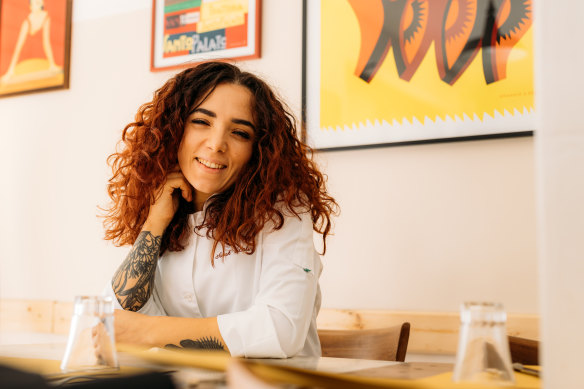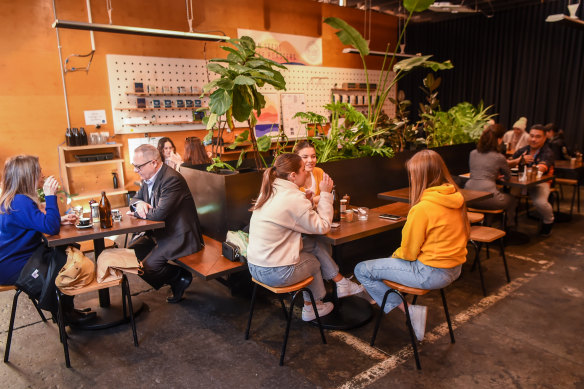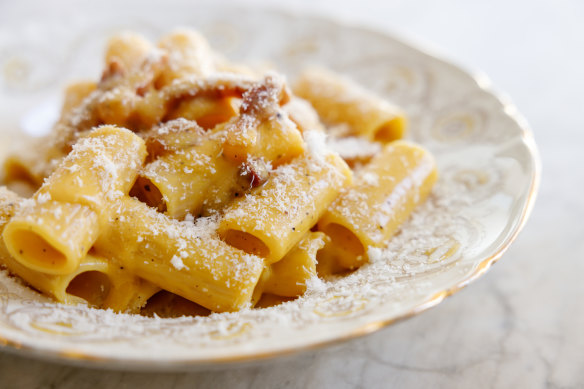
Four easy tips (and one great recipe) to raise your carbonara game. And no, there is no cream to be seen.


One of Rome’s best-known young chefs, Sarah Cicolini, is known for her rule-breaking pasta and her ever-packed 35-seat trattoria San Palato.
Cicolini ups the ante on traditional Roman cuisine with clever twists aimed at a new generation of pasta lovers. And at the top of the must-try list is her take on one of the most classic recipes of all, pasta carbonara.
“For me, pasta is something like magic,” says Cicolini. “[Italian filmmaker Federico] Fellini once said, ‘life is a combination of magic and pasta’, and I would have to agree.”
Cicolini has enlisted friends from Melbourne pasta destination Tipo 00 and wine guy Giorgio De Maria to recreate the Santo Palato experience down under as part of the Melbourne Food and Wine Festival.

She’s taken over Carlton coffee roaster Seven Seeds for the 10-day pop-up, which is selling out fast.
“Perhaps what makes my pasta so special is that I cook pasta ‘al chiodo’, which means firmer than al dente,” she says.
This way of cooking pasta, growing in popularity among young Italians, gives the pasta a hint of crunch because the dough remains slightly raw in the middle.
Here is what home cooks can learn from her lauded carbonara recipe.
Four tips for perfect carbonara
- We’ve heard you need to boil your pasta, in this case rigatoni, in a lot of vigorously boiling water. Cicolini recommends 1 litre for every 100 grams of pasta. That is a big pot. It means the pieces of pasta are constantly moving in the water and therefore cook more evenly with fewer clumps. And salt the water, of course. You can absolutely taste the difference in the result.
- Use guanciale instead of bacon. Guanciale is salt-cured and slow-aged meat from the cheek of a pig. Bacon comes from the belly or the back, by contrast. It is fattier and, as such, imparts more depth of flavour. Worth every step of you seeking it out.
- In a non-traditional power move, Cicolini makes a zabaione with the egg yolks and whites. Sounds hard, but is not at all. Zabaione, or zabaglione, is normally a dessert made with egg yolks, sugar, and a sweet wine (often marsala) beaten in a copper bowl over a boiling water bath to pasteurise the eggs. (This means the eggs are warmed – and any bacteria is killed – without being actually cooked.) Here, Cicolini employs a similar technique to create a foamy egg-based sauce. Apparently, if you don’t have a copper bowl, heatproof glass is the next best choice. Stainless steel bowls heat too quickly, and you’ll end up with scrambled eggs.
- Use pecorino instead of parmesan cheese. Pecorino is made from sheep’s milk and is saltier than parmesan, with a punchier flavour.

SARAH CICOLINI’S CARBONARA
INGREDIENTS
- 300g guanciale, cut into small cubes (pepper-covered skin removed)
- 5 egg yolks
- 60g egg whites (about 1½ eggs)
- 200g grated pecorino romano, plus extra to finish
- 500g rigatoni pasta
- black pepper
METHOD
- Fill a big saucepan with water, add some salt and bring it to a boil: in proportion, there should be 1 litre of water for every 100 grams of pasta.
- While the water boils, place a cast-iron pan over medium heat and cook the guanciale for at least 10-15 minutes, carefully turning every cube to make it crispy. Save the fat and put the guanciale cubes on paper towels to drain a little.
- Now it’s time to make the savoury zabaione. Put the egg yolks and whites in a copper or glass bowl, add some of the guanciale fat and the pecorino and beat it with a whisk until it becomes smooth. Still whisking, carefully place the bowl over a saucepan of gently simmering water, like a bain-marie or double boiler, to pasteurise the eggs without cooking them. Whisk for several minutes.
- Cook the rigatoni and remove it 2 minutes before the suggested cooking time. Save 1 cup of the pasta cooking water.
- Put the remaining guanciale fat in a large, deep frypan over medium heat, add the drained rigatoni and some of the cooking water (½ a cup to start), and stir it for 3 minutes.
- Turn off the heat and put the egg and pecorino mixture in the pan, then stir it again with the rigatoni to make it as creamy as possible, adding a little more cooking water if necessary. Divide the pasta among 4-5 bowls, add some of the crispy guanciale to each and finish with grated pecorino and freshly ground black pepper before serving.
For tickets to see Sarah Cicolini at the Melbourne Food and Wine Festival, go to melbournefoodandwine.com